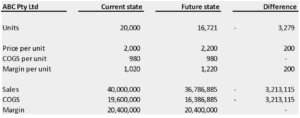
If you want to make more money, increase your prices. There, I said it!
Now, your brain is probably flooded by a range of reasons why you couldn’t possibly do that and maybe the notion that I must be some sort of lunatic.
And one of those reasons is the fear that you will lose customers if you increase prices. I won’t say that isn’t true – you have just altered the value equation and it is probably more likely than not that some come customers will walk away if you suddenly jack your prices with no corresponding increase in utility.
But before you dismiss the notion entirely, spend a moment to consider the following example:
Example
ABC Pty Ltd supplies turbo chargers to performance shops throughout the South Pacific and some parts of South East Asia. They are selling 20,000 units at $2,000 each which equates to $40m in sales annually. Each unit costs $980 so the margin per unit is $1,020 or $20.4m total.

Now, the company’s CFO crunches some numbers. She wants to push through a price increase of $200 per unit. That’s a 10% price jump. She knows the Board will worry what impact that will have on unit sales, so she prepares the analysis above.
She shows the Board that the company will make the same margin ($20.4m) even if it sells 3,279 less units. That’s a 16.39% (or roughly 1 in 6) drop-off in the number of units sold. If they can do better than that, then they are in the black. If they do worse than that, they are in the red.
How would you do better?
Look, it helps if you are in a strong position with your customers. If they have few choices and yours is a quality product, it’s likely there will be some ‘stickiness’ with your customers.
It also helps if you can justify the increase. Often, it’s been a long time since the last increase, and your costs have probably risen in the intervening period.
Customers may not like it, but they grudgingly accept your explanation because they can relate to what you say. They are probably going through the same thing.
And remember that price is only one part of the value equation. What could you do to enhance the value proposition?
The product itself may have changed. It may be a better product. You could improve the warranty period, ship smaller quantities more frequently, improve the packaging so there are less returns.
This might give you the breathing space to offer better payment terms or it might fund those volume rebates you have been thinking about.
Anyway, you get the drift. You know your business, go looking for the opportunities.
Other savings
Thinking about the ABC Pty Ltd example, what else do you think might happen if the number of units sold should decrease?
High margin, low volume businesses require less ‘muscle movements’ to generate the same outcome. In other words, in some ways, things get easier.
You may require less warehouse space, less shipments, less overtime, less staff or you could keep the same number of staff to serve fewer customers but use all that spare time to really ramp up your customer service.
What could you do differently/better if you increased margin and decreased volume?
Commensurate changes
As human beings, we want congruence. If we are going to pay more, we have to feel that that makes sense. Think about this:
The indicative drive away price for a brand-new BMW M340i is $126,087. Meanwhile, the Toyota Camry SL – which is also a 6-cylinder, 4-door sedan – can be yours for just $51,420. (1).
Most people would agree that the BMW is a better car. Though that depends on how you look at it. Is it really 2.5 times better or did they just jack their prices so far that they only have to sell a few units to get to where they want to be? And notice that their ‘direct competitors’ like Mercedes bring their 6-cylinder jobbie in at almost the same price as the BMW.
Now, if you’re buying the BMW, you want the whole experience to add up to the luxury price-point. Not just the product, but the sales process, how they make you feel, the after-sales service – it all needs to be top notch otherwise you start thinking about the utility of the product and seeing it as a conveyance to get from point A to point B in relative comfort and with a high degree of reliability.
So, your marketing, branding, packaging, positioning all need to be congruent with the price point. If you’re going to increase prices, make sure you think it through.
The point is, choose where and what you want to be and set yourself up that way. Is there a price increase in your future?
If you would like to run this exercise with your numbers, we’d be happy to help. Give us a call on 1300 656 141 to get the ball rolling.
(1) Per Carsales.com.au as at 20 May 2021


